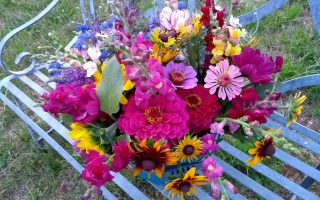January • Top Tips For Your Garden


The start of the year from our resident gardening expert
These tips are based on our garden in the Limousin but can be adapted to your area just as well. As with every year for the gardener, ‘Hey get moving there’s lots to be done‘.
 Now that the festive season is all over and done with, it’s that time of year where lethargy can easily set in as we await spring time. So this year, make one of your resolutions along with quitting smoking and getting more exercise, a ‘to do more’ in the garden at this time, it will certainly help with the former two mentioned.
Now that the festive season is all over and done with, it’s that time of year where lethargy can easily set in as we await spring time. So this year, make one of your resolutions along with quitting smoking and getting more exercise, a ‘to do more’ in the garden at this time, it will certainly help with the former two mentioned.
First things first, all of you that brought live Christmas trees into your house need to be getting them back outside. Put them in partial shade at first to harden them off, and then move them into full sun in a week or two, rinse off the foliage & water.
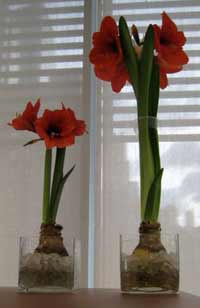 Plants received as Christmas gifts. Keep the tender ones like amaryllis and kalanchoe indoors in a well-lighted area; and water regularly.
Plants received as Christmas gifts. Keep the tender ones like amaryllis and kalanchoe indoors in a well-lighted area; and water regularly.
Move hardier plants like azaleas, cinerarias, cyclamen and cymbidiums outdoors to a protected spot after they have finished flowering. Remember to fertilize them after they have bloomed.
The December weather has probably got your garden confused and what the future months hold is anyone’s guess, but as always, be vigilant as the rule of thumb is perfect planning prevents, pathetically poor performance. So have those fleeces, blankets and cardboard boxes to hand and keep up with the weather reports and cover frost-tender outdoor plants. Ideally do not let the covering touch the leaves (so do the best you can) and remember to remove the protective covering in the morning.
Planning:
 The seed catalogues will be arriving shortly, if not already. Make your selections and ensure you order seeds early, don’t wait until late in the winter to order seeds because many varieties can and do sell out early.
The seed catalogues will be arriving shortly, if not already. Make your selections and ensure you order seeds early, don’t wait until late in the winter to order seeds because many varieties can and do sell out early.
Now remember to use your garden journal/note book/diary that you used last year to collect information about your garden. Refer back to it, and choose seeds that you think will enhance your garden this year.
Have you drawn a map of your garden? If not consider doing so and remember to make some copies of it.
Garden beds and raised beds normally stay in the same place year after year, unless you decide to change their location or are adding new ones.
The seasoned vegetable grower will be well aware of the importance of yearly crop rotation and what you have or have not, to put in the ground for this years proposed crops.
Either way, to plan this year’s garden, take a clean copy of your map and record the information your garden provides you with, you can use the back of your plan to record notes. Keep each year’s plan in a three-ring binder for easy cross-checking of varieties, rotations, etc. Also to note, what did well and what did not.
Now is a great time to source for evergreen shrubs such as azalea, camellia and early rhododendrons.
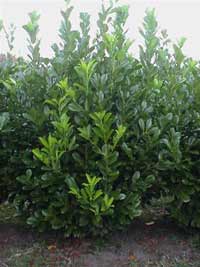 And on the subject of evergreens, though trees this time. It will soon be ‘chain saw’ season here in the Limousin. Therefore, you may want to consider looking at your landscape. Do you need evergreens to protect your privacy, act as a wind break, and reduce street noise (not guaranteed against rotovators or chain saws sadly) or to block the glare of street lights? Yes, yes I know, but we all do not live in the countryside). If you do, then consider ordering plants in January and February for spring planting.
And on the subject of evergreens, though trees this time. It will soon be ‘chain saw’ season here in the Limousin. Therefore, you may want to consider looking at your landscape. Do you need evergreens to protect your privacy, act as a wind break, and reduce street noise (not guaranteed against rotovators or chain saws sadly) or to block the glare of street lights? Yes, yes I know, but we all do not live in the countryside). If you do, then consider ordering plants in January and February for spring planting.
For the vegetable grower who wants to try something different, now is the time to start ordering tubers of Jerusalem artichoke (Helinathus tuberous). Though before ordering, do your homework as its not everyone’s cup of tea.
Have you got hold of that tree surgeon yet? If not you are running out of time. The same goes for finding gardeners and garden designers. Remember, if this is your holiday home, that ground clearance will still be there when you come over at Easter and you will have to do it.
Planting:
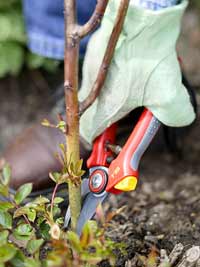 Wintertime is normally not associated with planting. However, for all those times you said “I’ll leave it till winter’ before you know it, you have ended up with that much to do that all of January is taken up with pruning, moving and planting .
Wintertime is normally not associated with planting. However, for all those times you said “I’ll leave it till winter’ before you know it, you have ended up with that much to do that all of January is taken up with pruning, moving and planting .
Winter planting does offer some advantages. For example, if you have tried to plant various plants in one area of your garden at another time of year and have very limited success, look at planting some of the cheaper less expensive winter varieties, if they grow well you will have more data for your garden detective work.
Cool-season annuals are still available. Iceland poppy, pansy, snapdragon, viola, stock, candytuft, calendula, cineraria and primrose.
You may even want to consider planting bare-root ornamentals such as roses, shade trees and vines.
Plant bare-root vegetables such as artichokes, asparagus, horseradish and rhubarb.
Plant bare-root fruits including apples, apricots, blueberries, cane berries, grapes, pears, plums and strawberries.
Maintenance:
 Probably the most important job in January.
Probably the most important job in January.
This is a good time to move dormant shrubs and trees if not already done.
Start to prune roses and most other deciduous shrubs. The cold snap 2/3 weeks ago should have seen off the unprotected climbing roses.
Start pruning dormant fruit trees, grape vines and shrubs. Remember to take out dead and diseased branches. Also remove crossing and closely parallel branches, then prune to shape.
If the weather is a little off kilter wait to prune spring-flowering shrubs until after they have flowered, do not do it now.
Again do not prune citrus trees! They are an evergreen and rely on an abundance of permanent branches to develop new fruit and to shade the trunk from sun burn.
Apply dormant spray to deciduous plants to control harmful over wintering insects. Those of you with peach trees may want to spray your peach tree with lime sulphur or fixed copper to control peach leaf curl.
Control slugs and snails by removing their hiding places and clean up leaf litter.
Avoid walking on grass or ground covers while they are frozen. The frozen leaves are brittle and easily damaged. Certain varieties of grass are especially sensitive to being walked on during the winter and large portions can die back, leaving bare spots for the spring.
Check perennials to see if any have been pushed out of the ground by alternate freezing and thawing weather. If they have, push them back into the soil. Otherwise the exposed roots will dry out and die. Replace any mulch that has been blown away.
Now this bit is important. If a few consecutive warm days (does this sound familiar) have caused your bulbs to nose out from under their protective mulch, then plan to thicken the mulch layer as soon as the cold weather returns to prevent freezing by exposure.
For indoor plants place slow release fertilizer on the soil around the base of indoor plants that flower or fruit in the winter.
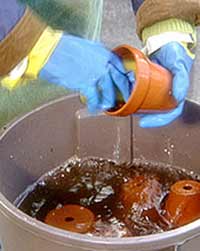 If not already done, sterilize your tools, pots and anything you use around your plants. Use one part household bleach to
If not already done, sterilize your tools, pots and anything you use around your plants. Use one part household bleach to
nine parts water. Soak for about 15 minutes, rinse and let dry.
If your pots are clay. This is a good time to clean them. Soak them in vinegar to help remove salt deposits.Soaking in a diluted solution of bleach (1 part bleach to 9 parts water) will kill micro-organisms. Remember NEVER combine any household chemicals for cleaning purposes, therefore complete the cleaning in two steps and start with the vinegar first and ensure they soak well in the rinsing process, repeat if they still smell of vinegar.For heavily crusted pots, scrub with a steel wool pad after soaking for 12 hours.
Get rid of damaged tools and replace. Now is a good time to take advantage of any off-season specials or the soldes on garden tools or attachments.
If you do have some time this winter paint the handles of garden tools red, orange or any vivid bright colour you choose. This will preserve the wood and make the tools easier to locate next summer when you lay them down in the garden or on the lawn.
Remember, when you do start to hear the chainsaws whirling, get your lawnmowers and other power tools in for their annual service and safety check.
Your wheelbarrow can support its own load if you add two sturdy wheels to the rear legs.
Fix and anchor a bar to each leg with a “U” screw and bolts. Attach the wheels to the ends of the bar with a bolt and washer on both the outside and inside of the wheel. Modifying a wheelbarrow like this cuts down on the strain of
lifting heavy loads by letting you push the wheelbarrow.
Well that is it for now. Stay warm!
Mark
•With thanks to Mark, Oak Garden Services
You can contact Mark directly if you would like more information on gardening or the services they offer
Tel: 05 55 98 62 03
Email: [email protected]
Share to: Facebook Twitter LinkedIn Email
More in countryside, garden, limousin, maps, summer, walking, work
By FrenchEntrée
Leave a reply
Your email address will not be published. Required fields are marked *

